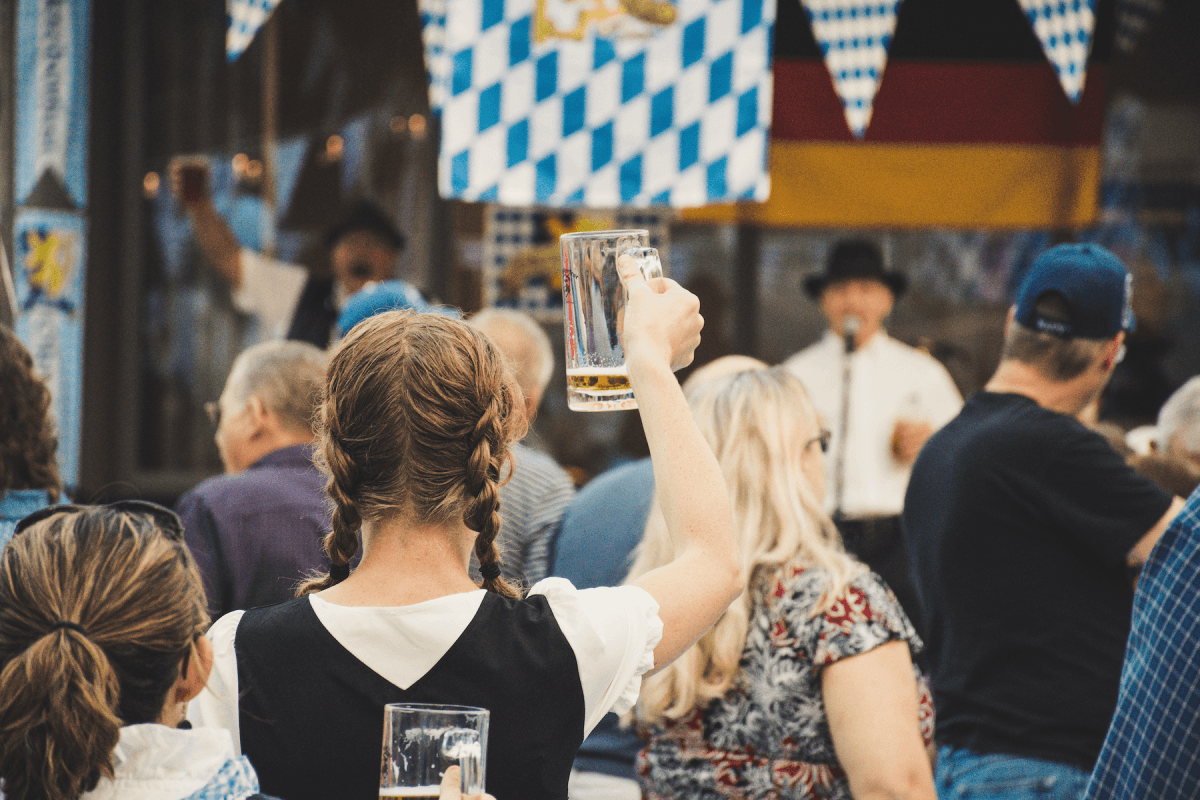Your cart is empty

Oktoberfest- The World’s Biggest Party and Much More
It’s that time of year again. The weather is changing and the leaves are starting to turn. But before it gets too cold, it’s time to get out your favourite lederhosen or dirndl of choice–that’s right, it’s Oktoberfest!
Every year, some 6 million odd visitors pilgrimage to Munich for the biggest beer festival in the world. Well, except for the past two years when festivities were put on hold (like most things).
During the event, nearly half a million roast chickens and over 7 million litres of beer will be consumed. Let’s take a closer look at all things Oktoberfest.
History of Oktoberfest
Oktoberfest didn’t use to be the world-famous party it is today. It began as a one-off celebration for the wedding of King Ludwig I to Princess Therese of Sax-Hildbrughausen on 12 October 1810. The festival’s main attraction was horse races to be run in the new couple’s honour. It was held at a meadow outside of the city called the Theresienwiese.
Declared a smashing success, the event organisers decided to run it back the following year. Quickly, the festival became an annual celebration with only a few exceptions due to wars and a cholera epidemic.
As the fest continued to evolve, more would be added to the spectacle. This included an agricultural show, bowling alleys, swings, large dance floors, and an assortment of booths and tents with their own attractions.
Beer rose to the forefront in 1887 when the inaugural parade of Oktoberfest staff and breweries took place. Since then, finely adorned horse teams show-off, among other things, barrels of beer as they help to open up the festivities on the first Saturday.
Since 1950, thousands gather on the first Saturday to watch the Mayor of Munich tap the first barrel. Whether it takes the mayor 2 blows of the hammer or 17, they then proclaim “O'zapft is!", meaning “it is tapped.”
After that, 12 gunshots will go off to signal the start of the festival for all in attendance and organised chaos ensues.
Modern Oktoberfest

Interior of the Marstall Wiesnfestzelt
Image courtesy of Oktoberfest.de
Today, millions of people gather at the Weisn every mid to late September to join in the celebration of Southern German traditions. The festival runs for 16 days leading up to the first Sunday of October. Beer flows heavily by the maß (1L), rotisseries chickens are cooked to succulent perfection, and pretzels as big as your face are had by all.
The variety of large and small tents ensures a comfortable spot for all in attendance. Fancy a bit of shooting with large amounts of alcohol already under your belt? Pop into the Schützen-Festzelt, pick one of 110 shooting ranges and choose to live dangerously (we’ll pass).
The modern fest has also become more inclusive with things like Rosa Wiesn, also known as Gay Oktoberfest. Starting in the 1970s, Rosa Wiesn lets thousands from the LGBTQ+ communities meet up and take on the spectacle of the fest together.
If beer isn’t your thing (but you’re reading this blog?), you can spend your time in the Weinzelt or “wine tent”. In this famous tent, the only beer available is hefeweizen. Instead, you can enjoy a wide range of German wines as you relax in cosy wooden boxes (unlike the standard trestle tables in most tents).
And if you like getting motion sick, the fest has that covered as well! You can pit your stomach full of booze and food against all manner of carnival rides including a “flip fly”, a giant spinning swing and the expected rollercoasters–pairs well with scopolamine or Dramamine.
One issue with Oktoberfest’s growing success and exposure is public drunkenness. Unfortunately, many of us are not used to downing german lager 1 litre at a time. The increased amount of tourism is correlated to the rise in what the beer locals refer to as bierleichen or “beer corpses”.
At any time of the day during the fest, hundreds to thousands of beer corpses can be found sick and laying down on the surrounding green spaces of the meadow. Now, as a responsible member of the beer community, surely that won’t be your final destination–always remember to pace yourself while shovelling down crisp german lager!
Oktoberfest Beer
The popular pale and golden beers of today are nothing like the original Oktoberfest beers.
Märzen
Also known as Märzenbier, Märzen is a Bavarian beer that can trace its roots back to the 16th century. During these times, Bavarian brewing laws only allowed for beer to be made between the 29th of September and the 23rd of April.
This was possibly due to high temperatures during fermentation in the summer months, resulting in bad beer. Other sources point to the fire hazards of 16th-century brewing in hot weather.
Either way, it meant the people’s supply of local beer was severely reduced for 5 months out of the year. To alleviate this, brewers came up with a hoppier, maltier, and slightly stronger beer that would age more gracefully. As the last beers brewed in April, Märzen would be aged in cellars or caves until being served at Oktoberfest.
Today Mäzens range from amber to dark brown in colour. The American Beer Judge Certification Program (BJCP) actually uses the name Oktoberfest and Märzen interchangeably.
Modern examples of these original Oktoberfest beers get their colour from the generous helpings of Vienna or Munich malts. They are usually clean, crisp, full of rich malt character and low on bitterness (20-28 IBUs).
Bavarian brewer Ayinger still brews their Oktoberfest-Märzen or Festmarzen which is a great example of the style. Märzen is a great lager with a deftly applied malty twist. Unfortunately, when you get to the Wiesn, none of this amber to brown beer can be found.
Festbier
The modern festival has graduated to pale, easy-drinking lagers. The beers served in the tents at Oktoberfest are much more akin to the Munich Helles style. These beers are slightly stronger than their counterparts but remain as stupidly balanced and drinkable as everyday pale lagers.

Oktoberfest patrons enjoying a maß of modern, pale Festbier
Image courtesy of Oktoberfest.de
Each year, many German brewers release a seasonal Festbier. This includes the “big six” Munich Breweries which are:
- Augustiner
- Hacker-Pschorr
- Löwenbråu
- Paulaner
- Spaten
- Hofbräuhaus
Every September you can look to your favourite beer merchants for examples from these brewers and more. If you can’t make it to the festival like the lucky few, then cracking open a Festbier at home is the next best thing.
Remember, it isn’t only about the beer. You will need a few other things to create your “Oktoberfest abroad”.
Lederhosen
Translated literally as “leather breeches”, lederhosen is a must when partaking in the spirit of Oktoberfest. In Bavaria, they are always referred to as proper “tract” meaning traditional garments.
These garments were once for working in the fields but now they are for special occasions. In Bavaria, you wear your tracht when you get married and get buried–and every year at Oktoberfest of course! The leather is great at stretching out with the ravages of age and normal life so a good set will last a lifetime.

An Oktoberfest attendee adorned in lederhosen, commonly referred to as tracht
Image courtesy of Oktoberfest.de
If you don't fancy yourself a bit of a leather daddy (or leather mum), then you can opt for a dirndl. This traditional Bavarian dress features a famous low neckline, a blouse, a wide high-waisted skirt and an apron. Originally peasant-ware, the dirndl became fashionable in the 19th century.
Lederhosen and dirndls can be found online. More authentic examples will set you back a few hundred quid. Maybe go cheap and cheerful for an at-home celebration. But should you invest in the real thing, be prepared to be mistaken for a local when you actually make it to the fest.
Food
While it's great to neck copious amounts of lager, it isn’t supposed to be a meal in a glass. Sheep in Wolf’s Clothing encourages responsible drinking at all times. There is nothing safer and surer to avoid becoming a bierleichen than to line your stomach with some tasty food.
If you’re fest’ing at home, here are some Oktoberfest-inspired dishes:
Wiesn Hendl- roast chicken; normally rotisserie style but a fan oven will do. Keep it simple with lemon, thyme and butter–brine it if you have the time!
Schweinshaxe- once a peasant food, translates as “pork knuckle”; a ham hock that is pickled, boiled, and then slow-roasted.
Käsespätzle- “cheese noodles”; a cheesy version of the classic egg noodle that is spätzle
Sauerkraut- delicious raw cabbage that has been fermented by lactic acid-producing bacteria. You can buy some fake, pickled stuff from the shop. Better yet, have a go at making some yourself!
Brezeln- the Bavarian pretzel. Unless you live near a German bakery, these will always end up better when homemade.
Until Next Time
That was fun, but now we’re thirsty, hungry and feeling the urge to strap on some leather! If like many of us, you don’t want to miss out on the Wiesn festivities- you can start by getting a hold of some good lager.
Our Munich Helles beers Lager Day Saints and Teutonic Knights will help escort oompah music and trestle tables straight to your home. Speaking of lagers, why not also fill your steins with some crisp Blue Balls Lager or some smooth Please & Thank You Rice Lager?
As for SiWC-branded lederhosen and dirndls, we’re still working on it!
We hope you all have a lovely time however you choose to celebrate. And remember, always drink responsibly (which is easier with low- and no-alcohol beers 😁).
- Choosing a selection results in a full page refresh.


